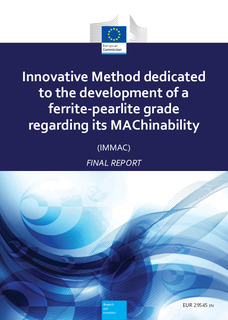Izenburua
Innovative Method dedicated to the development of a ferrite-pearlite grade regarding its MAChinability (IMMAC): final reportEgilea
Egilea (beste erakunde batekoa)
Argitalpen data
2019Beste erakundeak
Asco IndustriesUniversité de Lorraine
Sidenor I+D
Centro Ricerche Fiat
Swerea KIMAB
RWTH Aachen University
École Nationale d'Ingénieurs de Saint-Étienne (ENISE)
Dokumentu-mota
LiburuaLiburuaHizkuntza
IngelesaEskubideak
© European Union, 2019Sarbidea
Sarbide irekiaArgitaratzailearen bertsioa
https://doi.org/10.2777/811585Argitaratzailea
Oficina de Publicaciones de la Unión EuropeaLaburpena
Ferrite-pearlite (FP) steels are the most common material for engineering and automotive industries (gear box parts, crankshaft, connecting rods, injection parts…). Without any extensive research, con ... [+]
Ferrite-pearlite (FP) steels are the most common material for engineering and automotive industries (gear box parts, crankshaft, connecting rods, injection parts…). Without any extensive research, considering the different morphology of ferrite-perlite possible to achieve, it may be assumed that the machining performances are highly dependent on the FP parameters. Nevertheless, even now, we observe larger tolerances on requirements specification on FP steels which cause variability on microstructure morphology not always perceptible with standard metallurgical characterizations.
In some case, the technical specification causes complex customer complaints between steelmakers and their customers: the microstructure seems as expected but unacceptable variability in machinability is observed. IMMAC project aims to develop a numerical method to predict the machining performances of designed FP steels depending on their microstructural parameters; and to use this method as a flexible steel development strategy to better design the machinability-improved grades tailored according to the part and its machining range. Three cutting technologies were studied: turning, drilling and broaching. The figure below shows a scheme of the research approach with proposed work packages (WP) interrelation. D0, D1 and D2 are main deliverables of the project. [-]





















